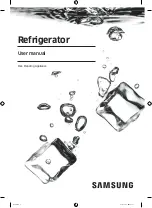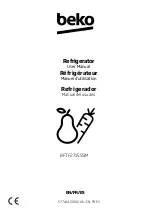
EN / 14
5 Preparation
Read the “Safety Instructions” sec-
tion first!
5.1 What to Do for Energy Saving
Connecting the product to elec-
tronic energy-saving systems is
harmful, as it may damage the
product.
• This refrigerating appliance is not inten-
ded to be used as a built in appliance.
• Do not keep the refrigerator doors open
for long periods.
• Do not place hot food or beverages into
the refrigerator.
• Do not overfill the refrigerator; blocking
the internal air flow will reduce cooling
capacity.
• In order to load the maximum quantity of
food into the freezer compartment of your
refrigerator, the upper drawers should be
taken out and the food should be placed
onto the wire/glass shelves. Net volume
and energy consumption information de-
clared in the energy label of your refriger-
ator was tested by taking out the upper
drawers in the cooler department and the
ice bucket, which is easily removable by
hand.
• Using the below drawer when storing is
strongly recommended.
• Depending on the product’s features; de-
frosting frozen foods in the cooler com-
partment will ensure energy saving and
preserve food quality.
• Make sure the foods are not in contact
with the cooler compartment temperature
sensor described below.
• If they are in contact with the sensor, en-
ergy consumption of the appliance might
increase
• Food shall be stored using the drawers in
the cooler compartment in order to en-
sure energy saving and protect food in
better conditions.
• Food packages shall not be in direct con-
tact with the temperature sensor located
in the freezer compartment.
5.2 First Use
Before using your refrigerator, make sure
the necessary preparations are made in
line with the instructions in "Safety and En-
vironmental Instructions" and "Installation"
sections.
• Keep the product running without placing
any food inside for 6 hours and do not
open the door, unless absolutely neces-
sary.
• The temperature change caused by
opening and closing of the door while us-
ing the product may normally lead to con-
densation on door/body shelves and
glassware placed in the product.
A sound will be heard when the
compressor is engaged. It is normal
for the product to make noise even
if the compressor is not running, as
fluid and gas may be compressed
in the cooling system.















































